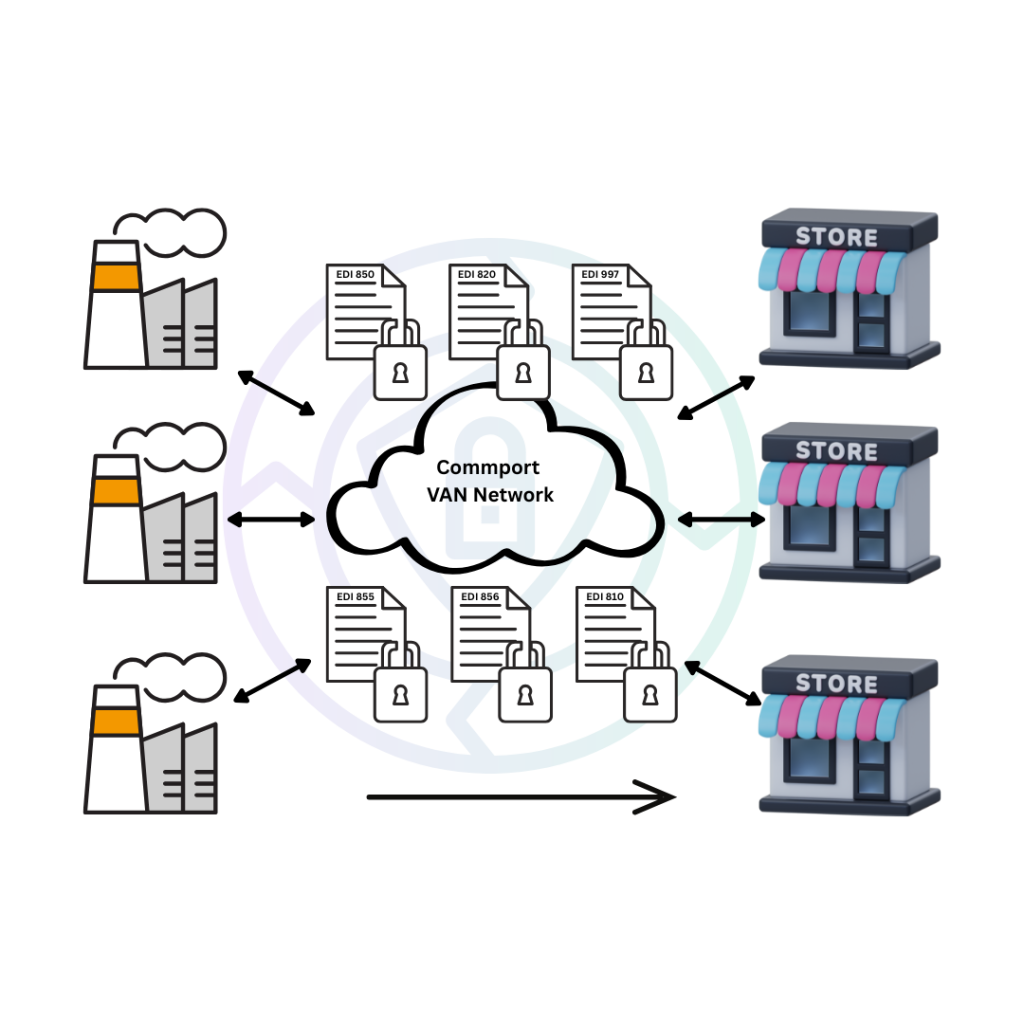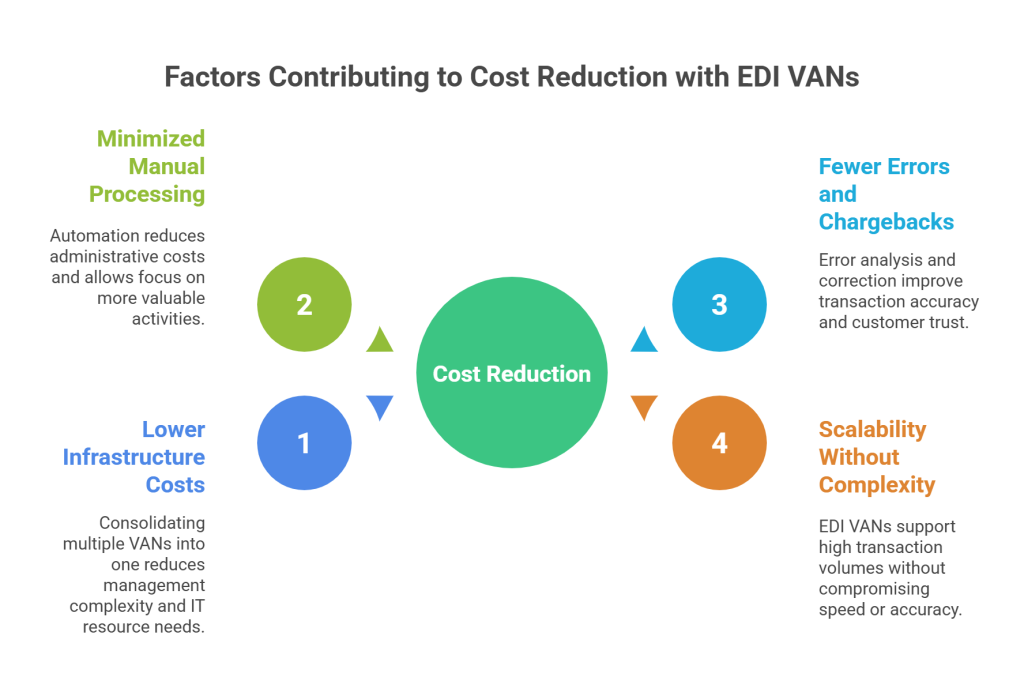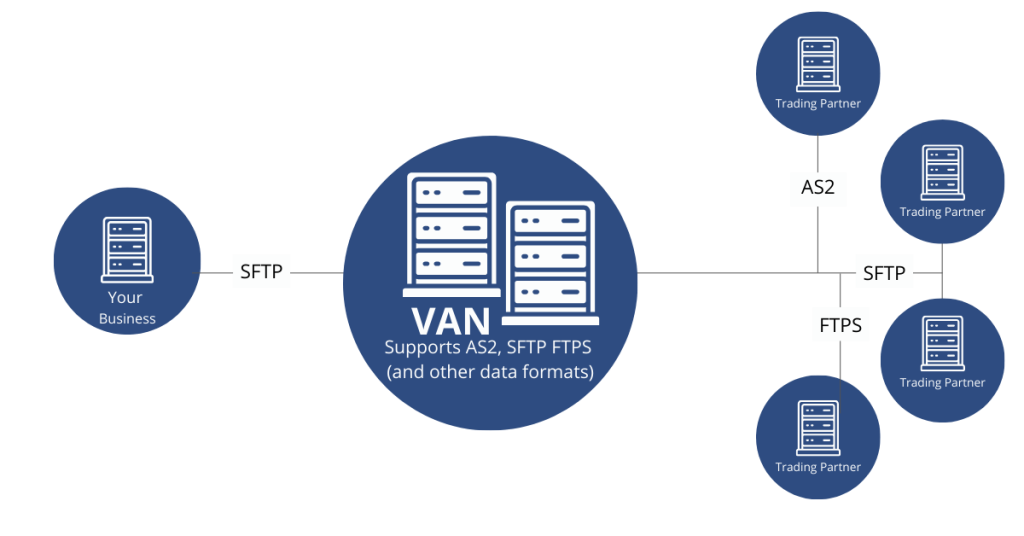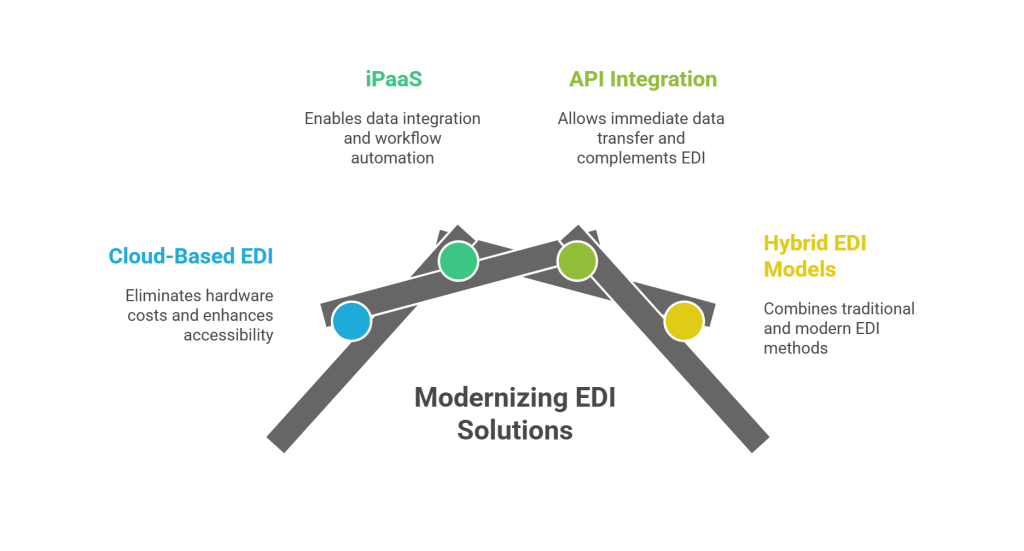Introduction
EDI VAN services are becoming essential for companies to create seamless communication channels between supply chain vendors and trading partners. At its core, an EDI VAN allows the exchange of standardized EDI documents by mapping and translating them into vendor-specific formats.
B2B EDI integration through these EDI VAN networks offers significant financial benefits – companies can save up to $50 or more per document by switching to electronic versions, and up to 60% in total transaction costs by reducing paper-based processes and manual labor.
We’ve seen firsthand how EDI integration challenges can hamper business growth. For instance, 42% of integration experts reported taking more than a month to onboard new trading partners in 2021, up from 37% in 2020. However, with the right EDI VAN provider, businesses can optimize their operations and gain a competitive advantage in the marketplace.
Key Takeaways
- EDI VANs act as secure intermediaries that simplify B2B communications by connecting businesses through one central hub instead of multiple direct connections.
- Companies save up to 60% on transaction costs by eliminating manual processing, reducing errors, and lowering infrastructure maintenance requirements.
- Enhanced security and compliance features include end-to-end encryption, authentication protocols, and regulatory compliance support for industries like healthcare and finance.
- Choose providers based on industry expertise and evaluate pricing models, implementation support, and scalability to avoid hidden costs and ensure long-term value.
- Modern alternatives like cloud-based EDI and APIs are emerging alongside traditional VANs, offering real-time data exchange and greater flexibility for growing businesses.
What is an EDI VAN and How Does it Work?
Understanding the mechanics behind EDI VAN services starts with breaking down what they are. Let me walk you through this powerful B2B communication tool that’s been streamlining business transactions for decades.

Definition of EDI VAN
An EDI Value-Added Network (VAN) is a secure, private network that facilitates the exchange of electronic data interchange (EDI) documents between trading partners. First and foremost, it functions as a central hub or intermediary between businesses, managing the flow of information through a virtual mailbox system.
Think of an EDI VAN as a specialized post office for business documents. When a company sends an electronic document, the VAN receives it, sorts it, and delivers it to the recipient’s digital mailbox. This seemingly simple process creates a standardized, secure channel for business communications that removes many of the complexities of direct connections.
The “value-added” component refers to additional services beyond basic transmission, including:
- Document encryption for enhanced security
- Protocol and format translation between different EDI standards
- Store-and-forward capabilities ensure delivery even when systems are down
- Detailed tracking, reporting, and audit trails for all transactions
How it fits into B2B EDI Integration
In the B2B EDI integration ecosystem, VANs serve as crucial connectors that simplify how businesses communicate electronically. Rather than managing numerous individual connections with trading partners, companies connect once to a VAN that handles all communications.
The integration process typically follows these steps:
- A business generates an electronic document (invoice, purchase order) using its system
- The document converts to a standardized EDI format
- The translated document is transmitted securely through the VAN
- The VAN validates the document and performs security checks
- The recipient’s system receives, translates, and processes the document
- An acknowledgment confirms successful receipt
Many VANs offer visibility tools showing delivery status and corresponding workflows, essentially eliminating the need for follow-up emails and phone calls. This integration method is particularly valuable for manufacturers communicating with suppliers and distributors, as these industries often utilize EDI VANs for streamlined communication.
EDI VAN vs Direct EDI Connections
The choice between direct EDI connections and VAN-based EDI presents distinct tradeoffs. With direct EDI, businesses establish peer-to-peer connections with each trading partner—an approach that quickly becomes complex and unwieldy as partner networks grow.
Conversely, using a VAN provides several advantages:
- Simplified connectivity: Companies manage one connection to the VAN instead of separate connections with each trading partner
- Enhanced security: VANs employ robust security measures, including encryption and authentication
- Protocol translation: Communication becomes possible regardless of which EDI protocol partners use
- Reliability: With redundant systems and 24/7 monitoring, VANs ensure high availability
Nevertheless, these benefits come with considerations. VANs typically charge per document or line item, with costs ranging from three to twenty cents per document depending on the service. Although the initial implementation cost is often lower than direct EDI, transaction fees can accumulate as volume increases.
Furthermore, onboarding new partners through a VAN can sometimes take longer—from three to six months in some cases. Despite these considerations, many organizations find that the central management, security, and connectivity benefits of VANs outweigh the transaction costs, especially for businesses that exchange documents with numerous trading partners.
Key Benefits of Using an EDI VAN
EDI value-added networks offer numerous competitive advantages for businesses looking to optimize their supply chain communications. Let me walk through the key benefits that make these systems invaluable for modern B2B integration.

1. Improved Data Security and Compliance
First and foremost, EDI VAN services provide robust security measures that protect sensitive business data during transmission. These networks employ advanced protection mechanisms, including:
- End-to-end encryption to safeguard business-critical information
- Strong authentication protocols that verify user identities
- Digital signature verification ensures nonrepudiation
- Password protection requiring registered credentials
Above all, these security features help organizations maintain compliance with industry-specific regulations such as GDPR and ISO 27001. This compliance framework gives businesses peace of mind when exchanging sensitive information with trading partners. Many EDI VANs analyze all transactions for potential errors and security issues, flagging problems before they cascade through your supply chain.
2. Faster Partner Onboarding
While traditional integration methods can create bottlenecks, EDI VANs simplify partner connectivity. They enable businesses to expand their networks without implementing complex individual integrations. This streamlined approach creates a foundation for stronger relationships with vendors through improved communication and efficiency.
Subsequently, companies can connect with more businesses since EDI VANs can translate files to comply with various protocol standards, opening doors to new business opportunities.
3. Protocol Translation and Automation
EDI VANs serve as universal translators for business documents. They can seamlessly convert data between different formats, enabling communication between organizations regardless of their internal systems. This interoperability eliminates the need for manual file conversions or complex point-to-point connections.
This capability streamlines business processes by automating traditionally manual tasks like data entry, document preparation, and validation. The automation facilitated by EDI VANs enables real-time data exchange, fostering instantaneous communication that accelerates decision-making.
4. Reduced Manual Errors
Manual data entry frequently leads to costly mistakes and processing delays. Thankfully, EDI VANs eliminate this risk by directly integrating with business systems. Companies can save up to 60% in transaction costs by reducing paper-based processes and manual labor.
Meanwhile, the use of standardized data formats minimizes misinterpretation and miscommunication, enhancing accuracy. Many EDI VANs offer automatic error correction capabilities, ensuring transactions remain accurate and reach recipients on time. This improves not only efficiency but also customer satisfaction through more reliable service.
5. Real-Time Transaction Tracking
EDI VANs record all information flowing through their systems, providing businesses with a complete ledger of each transaction. This comprehensive audit trail proves invaluable for resolving disputes and referencing historical data.
Coupled with tracking capabilities, these networks offer real-time visibility into message transactions and processing. Detailed monitoring allows for quick issue resolution and more informed decision-making throughout your supply chain. Most providers also implement automated alerts for failed transmissions, delays, or security concerns, enabling proactive problem-solving before issues affect your business operations.
To this end, the integration of EDI VAN services creates enhanced supply chain visibility, allowing companies to monitor inventory levels and respond more effectively to disruptions.
How EDI VANs Help Reduce B2B Transaction Costs
The economics of B2B transactions change dramatically when EDI VANs enter the equation. Companies can save up to 60% in transaction costs by reducing paper-based processes and manual labor. These savings materialize across several crucial areas that directly impact your bottom line.

1. Lower Infrastructure and Maintenance Costs
First, EDI VANs eliminate the complexity of managing dozens of direct links by acting as a universal adapter for all your partners. This consolidation yields immediate financial benefits as 77% of businesses typically manage multiple VANs—some maintaining as many as 10 or more. By consolidating to a single VAN, you’re reducing complexity and freeing up valuable in-house IT resources.
EDI-as-a-service options further reduce costs by removing the need to build internal EDI functions. Given that EDI skills are scarce, hiring and managing internal teams can be prohibitively expensive, specifically for smaller businesses. Moreover, 51% of companies report improved data quality and accuracy after optimizing their B2B integration solutions.
2. Minimized Manual Processing
The heart of EDI is automation, which dramatically reduces administrative costs. Therefore, when your company grows and transaction volumes increase, an effective EDI VAN scales to handle the added demand without requiring additional staff.
Automating document exchange eliminates manual data entry, consequently reducing processing time and human intervention. This efficiency allows your team to focus on more valuable activities. Specifically, 41% of businesses report increased automation for error reduction after optimizing their EDI solutions.
3. Fewer Errors and Chargebacks
Many EDI VANs analyze all transactions flowing through their systems to identify errors. Some providers even automatically correct these mistakes to ensure transactions remain accurate. As a result, your business maintains better customer and supplier ratings, building trust that can lead to increased business opportunities.
The improved reporting on transactions that a single VAN provides delivers insights into the overall health of your company. This visibility helps prevent costly errors before they impact your operations or trigger chargebacks from trading partners.
4. Scalability Without Added Complexity
Without a scalable solution, companies often face increased costs, slower processing speeds, and unnecessary complexities—issues that become especially apparent as transaction volumes grow. In contrast, a scalable EDI VAN effortlessly supports high volumes without compromising speed or accuracy.
Many businesses make the mistake of sticking with their initial EDI solution because it initially “works,” failing to recognize the long-term costs of using a solution not built for growth. Hidden fees and rigid pricing structures can add up quickly as your business expands. Alternatively, a scalable EDI VAN offers clear, predictable pricing without hidden costs, ensuring your business can grow without constantly facing unexpected fees or operational bottlenecks.
Choosing the Right EDI VAN Provider
Selecting an optimal EDI VAN provider requires careful evaluation, as your choice will affect both operational efficiency and bottom-line savings. Finding the right partner involves assessing multiple factors beyond just price.

What to Look for in a Provider
First and foremost, seek providers that support any standards or formats your business needs. This includes compliance with ANSI X12, EDIFACT, and Tradacoms standards, plus support for non-EDI formats like XML, CSV, and JSON. Simultaneously, evaluate their industry expertise, as providers with experience in your specific sector will better understand your unique requirements and regulatory landscape.
Look for solutions offering end-to-end visibility throughout your EDI processes, which proves invaluable for troubleshooting and maintaining control. Additionally, consider their capability to expedite trading partner onboarding, as this directly impacts how quickly you can expand your business network.
Questions to Ask Before Signing a Contract
Before committing, inquire about:
- Is your potential trading partner requiring you to be on the same VAN?
- Does the provider charge for translation services?
- Will you get locked into a long-term contract, or can you leave with reasonable notice?
- What implementation support is included in the base price?
- How does the provider handle security and compliance with regulations relevant to your industry?
Throughout your evaluation, pay close attention to hidden costs like setup fees, data mapping charges, and ongoing maintenance expenses. Remember that implementation timelines typically range from “a few weeks to a few months,” depending on your business size and complexity.
Comparing Pricing Models and Service Levels
Most providers offer either subscription-based or transaction-based pricing models. Transaction-based pricing often charges per kilo-character (where one KC equals 1,000 characters), which means costs increase proportionally with business growth. Comparatively, trading partner pricing charges a fixed monthly amount per active partner, making costs more predictable.
In light of long-term considerations, calculate the total cost of ownership, including implementation, training, ongoing maintenance, and support fees. Throughout this process, Commport Communications has offered both EDI and VAN services since 1985. For 4 decades, Commport is the trusted B2B network solutions provider for over 6000+ brands worldwide. Offering seamless connectivity, scalable solutions, and easy integration with other 3rd party ERPs and apps. Book a free consultation today.
Modern Trends and Alternatives to Traditional VANs
The EDI landscape is evolving rapidly as businesses seek more flexible solutions beyond traditional VANs. These modern alternatives offer enhanced capabilities for b2b edi integration while addressing contemporary challenges.

1. Cloud-Based EDI and iPaaS
Cloud-based EDI van services eliminate the need for expensive in-house hardware while improving accessibility. Team members can access data seamlessly, whether in the office or working remotely, enhancing efficiency between organizations and trading partners. Notably, small and medium-sized businesses benefit from lower upfront costs.
Integration Platform as a Service (iPaaS) represents another significant advancement, enabling nontechnical users to integrate data from multiple applications into a centralized cloud solution. This technology helps companies automate workflows between systems, providing real-time data synchronization. According to forecasts, the iPaaS market exceeded $9 billion in 2024 and is expected to reach $17 billion by 2028.
2. API Integration with EDI Systems
Application Programming Interfaces (APIs) increasingly complement traditional EDI value added network systems. Unlike conventional EDI processing at scheduled intervals, APIs allow immediate data transfer. IBM estimated that 50% of transactions will be completed via APIs by 2023.
3. Hybrid EDI Models for Flexibility
Many organizations now implement hybrid approaches combining traditional EDI van provider services with APIs and cloud solutions. These hybrid models deliver greater flexibility, faster data exchange, and integration with more systems. Throughout the industry, businesses are adopting solutions that handle various EDI types from within a singular intuitive interface.
Conclusion
EDI VAN services stand as a cornerstone technology for businesses seeking to streamline their B2B communications while significantly reducing transaction costs. Throughout this guide, we’ve explored how these specialized networks function as secure intermediaries, simplifying partner connections and automating document exchanges. Consequently, companies can achieve up to 60% reduction in transaction costs by eliminating manual processing, minimizing errors, and lowering infrastructure requirements.
The right EDI VAN provider offers much more than simple document transmission. Above all, these services deliver enhanced security, faster trading partner onboarding, seamless protocol translation, and real-time visibility into your supply chain operations. Therefore, when selecting a provider, businesses must carefully evaluate industry expertise, pricing models, and implementation support to maximize their return on investment.
While traditional EDI remains essential, the landscape continues evolving with cloud-based solutions, API integrations, and hybrid models offering even greater flexibility. Certainly, these modern approaches address the growing demands for real-time data exchange and seamless connectivity across diverse business systems.
The decision to implement an EDI VAN solution represents a strategic investment in your company’s operational efficiency. When properly executed, this technology not only reduces immediate transaction costs but also positions your business for sustainable growth through improved partner relationships and streamlined supply chain processes. Thus, whether you’re just beginning your EDI journey or looking to optimize existing systems, the right VAN solution will help your business thrive in today’s interconnected commercial environment.
Commport EDI and VAN Services
Download: VAN Buyers Guide
Maximize your business efficiency with the right VAN provider! Grab your free VAN Buyer's Guide and discover the key features and services that will elevate your EDI transactions to the next level.
Make an informed decision today!
Frequently Asked Questions
An EDI VAN (Value-Added Network) is a secure, private network that facilitates the exchange of electronic documents between business partners. It acts as a central hub, simplifying connections and automating document exchanges, which can lead to up to 60% reduction in transaction costs by eliminating manual processing and reducing errors.
EDI costs vary depending on the provider and volume of transactions. Many providers use a tiered pricing model based on the number of transactions or characters processed. For example, you might pay between $0.30 to $0.50 per transaction for 500-1000 transactions per month, resulting in a monthly cost of $150 to $250.
EDI VANs provide robust security features including end-to-end encryption, strong authentication protocols, digital signature verification, and password protection. These measures help businesses maintain compliance with industry-specific regulations such as HIPAA and GDPR, ensuring the safe transmission of sensitive business data.
EDI VANs offer simplified connectivity, enhanced security, and protocol translation, allowing businesses to manage a single connection instead of multiple direct connections with trading partners. While VANs typically charge per document or transaction, many organizations find that the benefits outweigh the costs, especially when dealing with numerous trading partners.
Modern alternatives to traditional EDI VANs include cloud-based EDI solutions, Integration Platform as a Service (iPaaS), and API integrations. These options offer greater flexibility, faster data exchange, and easier integration with various business systems. Many organizations are adopting hybrid models that combine traditional EDI with these newer technologies to meet evolving business needs.





